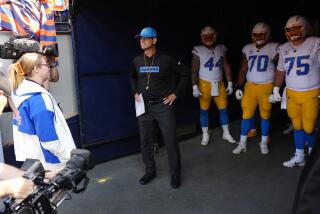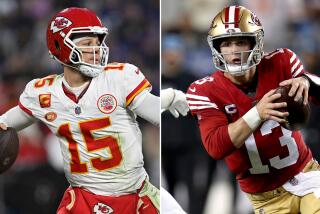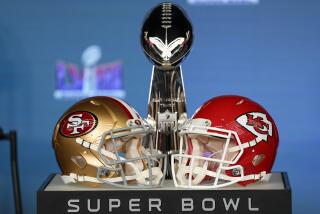Getting back in the game
- Share via
Getting to a Super Bowl is often as much a triumph over injury as it is over an opponent.
By the time the big game rolls around, players have endured a season’s worth of being bashed, slammed and trampled. Most are nursing at least one nagging injury -- a jammed finger, pulled muscle or an ankle sprain, to name just a few.
“By the Super Bowl, it seems like all the guys are dealing with chronic injuries,” said Lindsy McLean, who retired last summer after 24 years as the head trainer of the San Francisco 49ers. “They’re basically playing on desire and adrenaline by that point.”
In many cases, the injuries aren’t much different from those suffered by weekend warriors playing basketball, racquet sports or bicycling. About 7 million sports injuries are treated annually in the United States, according to the federal Centers for Disease Control and Prevention in Atlanta. Muscle strains and ankle sprains account for the bulk of them -- almost a third, at 31% -- and they are especially prevalent among those 30 and older.
“We’re an aging society and sports injuries like these are very common,” said Dr. Tom Vangsness, a professor of orthopedic surgery at USC. “You get older and you’re stiffer, tissues aren’t as supple and they don’t repair themselves like they used to.”
The care of sprains and strains suffered by weekend athletes and by Super Bowl-bound players are generally the same. Treatments include increasing blood flow to promote healing, beginning a light conditioning program for strength and getting plenty of rest.
The resources -- and timetables -- for such treatment, however, can be vastly different. Sprains and strains typically take six to eight weeks to heal properly, sometimes less for a pro athlete in top condition. But because of the enormous psychological and financial pressures surrounding a Super Bowl game, players are almost desperate to take part in what has become a national phenomenon. “You’ve got just one game to get through at that point -- and players are just going to find a way to do it,” said McLean.
A couple of key Super Bowl players illustrate the accelerated and intensified treatment program football players usually undergo: Carolina Panther running back Stephen Davis and New England Patriot linebacker Tedy Bruschi. Both were expected to see at least some action Sunday, despite painful injuries.
Davis, one of the league’s leading rushers this season, pulled a quadriceps muscle as he sprinted 64 yards in a divisional playoff game Jan. 10.
Such injuries, routine among pros and amateurs alike, are usually caused by a combination of fatigue, dehydration and muscle tightness.
For a pro football player, treatment usually includes daily ice applications, light stretching, deep massage and electrical stem therapy, said McLean. (Stem therapy uses an electrical device that causes the injured muscle to gently contract, improving blood circulation and thus promoting recovery.)
A week after his injury, however, Davis was back on the field for another game -- far sooner than a physician would recommend for the average person. Although he was used sparingly, Davis still scored a touchdown.
But pro athletes, or even weekend warriors, who put themselves back into action too quickly risk further damage.
Bruschi, a leading defensive player for the Patriots, badly strained a calf muscle in the final two minutes of the AFC championship game on Jan. 18. The injury was caused when he jammed his right foot into the ground during a play.
Although not as serious as damage to an Achilles tendon, a strained calf muscle can still be debilitating.
“You can’t push off at all,” said McLean. “It’s very difficult to run with any burst of speed. It locks up on you and you go into spasms.”
In addition to regular icing to decrease swelling, treatment for a strained calf also calls for light strengthening exercises. Usually, the player rides a stationary bike and begins a program of toe and calf raises.
The extra work is supposed to help condition the muscle and speed recovery.
Bad calf and leg muscles are only a few of the injuries an athletic trainer would treat during Super Bowl week, said McLean.
Another common one is ankle sprains that cause soreness and reduce mobility.
When the 49ers traveled to the site of a Super Bowl, McLean said they typically brought along one or two extra trainers in addition to the three that always traveled with the team.
Their hotel suite would quickly be transformed into a physical therapy room, he said.
It would be filled with padded tables, electrical stem machines and perhaps the most essential treatment element of all -- ice. Players would soak arms, legs, elbows, ankles to reduce inflammation and alleviate pain.
“We go through huge amounts of ice,” said McLean. “Huge.”
More to Read
Go beyond the scoreboard
Get the latest on L.A.'s teams in the daily Sports Report newsletter.
You may occasionally receive promotional content from the Los Angeles Times.










